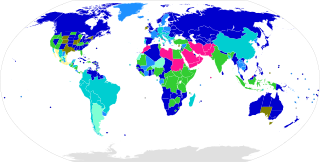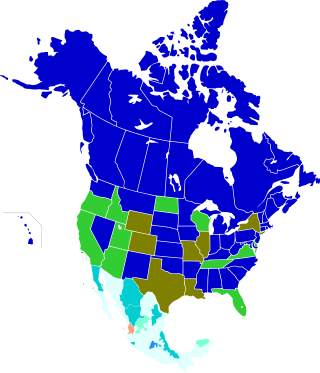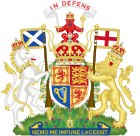
The age of consent is the age at which a person is considered to be legally competent to consent to sexual acts. Consequently, an adult who engages in sexual activity with a person younger than the age of consent is unable to legally claim that the sexual activity was consensual, and such sexual activity may be considered child sexual abuse or statutory rape. The person below the minimum age is considered the victim, and their sex partner the offender, although some jurisdictions provide exceptions through "Romeo and Juliet laws" if one or both participants are underage, and are close in age.
Child sex tourism (CST) is tourism for the purpose of engaging in the prostitution of children, which is commercially facilitated child sexual abuse. The definition of child in the United Nations Convention on the Rights of the Child is "every human being below the age of 18 years". Child sex tourism results in both mental and physical consequences for the exploited children, which may include sexually transmitted infections, "drug addiction, pregnancy, malnutrition, social ostracism, and death", according to the State Department of the United States. Child sex tourism, part of the multibillion-dollar global sex tourism industry, is a form of child prostitution within the wider issue of commercial sexual exploitation of children. Child sex tourism victimizes approximately 2 million children around the world. The children who perform as prostitutes in the child sex tourism trade often have been lured or abducted into sexual slavery.

The Sexual Offences Act 2003 is an Act of the Parliament of the United Kingdom.
Sexual Offences Act is a stock short title used for legislation in the United Kingdom and former British colonies and territories such as Antigua and Barbuda, Crown dependencies, Kenya, Lesotho, Republic of Ireland, Sierra Leone, South Africa and Trinidad and Tobago relating to sexual offences.

Sexual grooming refers to actions or behaviors used to establish an emotional connection with a minor, and sometimes the child's family, to lower the child's inhibitions with the objective of sexual abuse. It can occur in various settings, including online, in person, and through other means of communication. Children who are groomed may experience mental health issues, including "anxiety, depression, post-traumatic stress, and suicidal thoughts."
The ages of consent for sexual activity vary from age 15 to 18 across Australia, New Zealand and other parts of Oceania. The specific activity and the gender of its participants is also addressed by the law. The minimum age is the age at or above which an individual can engage in unfettered sexual relations with another person of minimum age. Close in age exceptions may exist and are noted where applicable. In Vanuatu the homosexual age of consent is set higher at 18, while the heterosexual age of consent is 15. Same sex sexual activity is illegal at any age for males in Papua New Guinea, Kiribati, Samoa, Niue, Tonga and Tuvalu; it is outlawed for both men and women in the Solomon Islands. In all other places the age of consent is independent of sexual orientation or gender.
The ages of consent vary by jurisdiction across Europe. The ages of consent – hereby meaning the age from which one is deemed able to consent to having sex with anyone else of consenting age or above, provided that the encounter does not involve commercial sex or a person in a recognized position of authority – are between 14 and 18. Some countries have close-in-age exceptions allowing partners close in age to engage in sexual acts. The vast majority of countries set their ages in the range of 14 to 16; only four countries, Cyprus (17), the Republic of Ireland (17), Turkey (18), and the Vatican City (18), set an age of consent higher than 16. The laws can also stipulate which specific activities are permitted or specify the age at which one or other sex can legally participate. The highlighted age is that from which a young person can lawfully engage in a non-commercial sexual act with an older person, regardless of their age difference, provided the older one is not in a position of power, a relative, or is committing another form of exploitation. All jurisdictions in Europe have equal and gender-neutral age limits.

In North America, the legal age of consent relating to sexual activity varies by jurisdiction.
Rape is a type of sexual assault initiated by one or more persons against another person without that person's consent. The act may be carried out by physical force, under threat or manipulation, by impersonation, or with a person who is incapable of giving valid consent.
Laws regarding incest vary considerably between jurisdictions, and depend on the type of sexual activity and the nature of the family relationship of the parties involved, as well as the age and sex of the parties. Besides legal prohibitions, at least some forms of incest are also socially taboo or frowned upon in most cultures around the world.
Laws against child sexual abuse vary by country based on the local definition of who a child is and what constitutes child sexual abuse. Most countries in the world employ some form of age of consent, with sexual contact with an underage person being criminally penalized. As the age of consent to sexual behaviour varies from country to country, so too do definitions of child sexual abuse. An adult's sexual intercourse with a minor below the legal age of consent may sometimes be referred to as statutory rape, based on the principle that any apparent consent by a minor could not be considered legal consent.

Lesbian, gay, bisexual, transgender (LGBT) rights in Scotland are generally in line with the rest of the United Kingdom, which have evolved extensively over time and are now regarded as some of the most progressive in Europe. In both 2015 and 2016, Scotland was recognised as the "best country in Europe for LGBTI legal equality".
In common law jurisdictions, statutory rape is nonforcible sexual activity in which one of the individuals is below the age of consent. Although it usually refers to adults engaging in sexual contact with minors under the age of consent, it is a generic term, and very few jurisdictions use the actual term statutory rape in the language of statutes. In statutory rape, overt force or threat is usually not present. Statutory rape laws presume coercion because a minor or mentally disabled adult is legally incapable of giving consent to the act. It is also considered as statutory rape even if the victim is above age of consent, and if the perpetrator is in an authority position such as a teacher, a doctor or a parent.
Simulated child pornography is child pornography depicting what appear to be minors but which is produced without their direct involvement.

There are a number of sexual offences under the law of England and Wales, the law of Scotland, and the law of Northern Ireland.
Child pornography is a type of erotic material that depicts persons under the age of 18. The precise characteristics of what constitutes child pornography varies by criminal jurisdiction.

The Sexual Offences (Scotland) Act 2009 is an Act of the Scottish Parliament. It creates a code of sexual offences that is said to be intended to reform that area of the law. The corresponding legislation in England and Wales is the Sexual Offences Act 2003 and in Northern Ireland the Sexual Offences Order 2008.
Barbados is a source and destination country for men, women, and children subjected to trafficking in persons, specifically forced prostitution and forced labor. Some children in Barbados are subjected to commercial sexual exploitation in “transactional sex” wherein a third party such as a parent receives a benefit from the child's participation in sexual activity. Researchers identified patterns of transactional sex within families, most often by adult male caretakers such as step-fathers, as well as child prostitution outside the home. Women from the Dominican Republic, Guyana, and Jamaica voluntarily enter Barbados as illegal migrants, and some expect to engage in prostitution. Some of these women are exploited in forced prostitution subsequent to their arrival. Some other foreign women who entered the country illegally are exploited in involuntary domestic servitude in private homes. Foreign men have been transported to Barbados for the purpose of labor exploitation in construction and other sectors. Sex traffickers, primarily organized criminals from Guyana, form partnerships with pimps and brothel owners from Trinidad and Tobago and Barbados, and lure women to Barbados with offers of legitimate work. Trafficking victims tend to enter the country through legal means, usually by air; traffickers later use force and coercion to obtain and maintain the victims’ work in strip clubs, massage parlors, some private residences, and “entertainment clubs” which operate as brothels. Traffickers use methods such as threats of physical harm or deportation, debt bondage, false contracts, psychological abuse, and confinement to force victims to work in construction, the garment industry, agriculture, or private households.

Child sexual abuse in the United Kingdom has been reported in the country throughout its history. In about 90% of cases the abuser is a person known to the child. However, cases during the second half of the twentieth century, involving religious institutions, schools, popular entertainers, politicians, military personnel, and other officials, have been revealed and widely publicised since the beginning of the twenty-first century. Child sexual abuse rings in numerous towns and cities across the UK have also drawn considerable attention.
There are a number of sexual offences under the law of Scotland.








